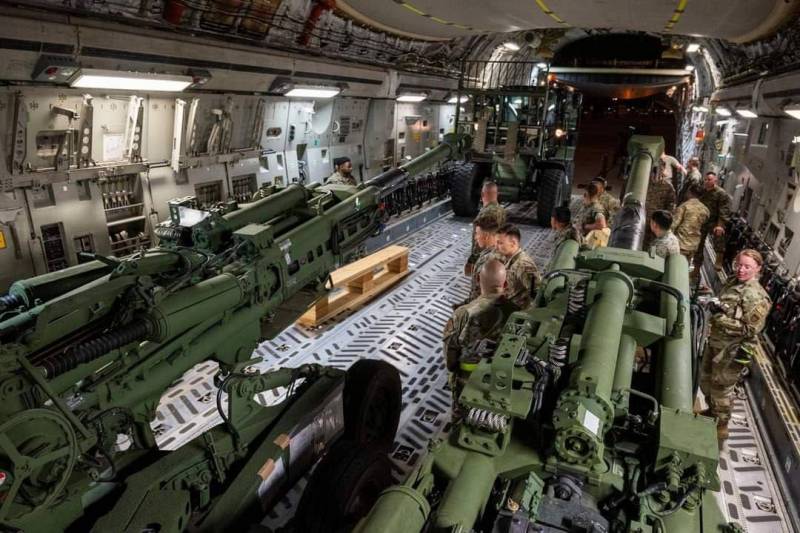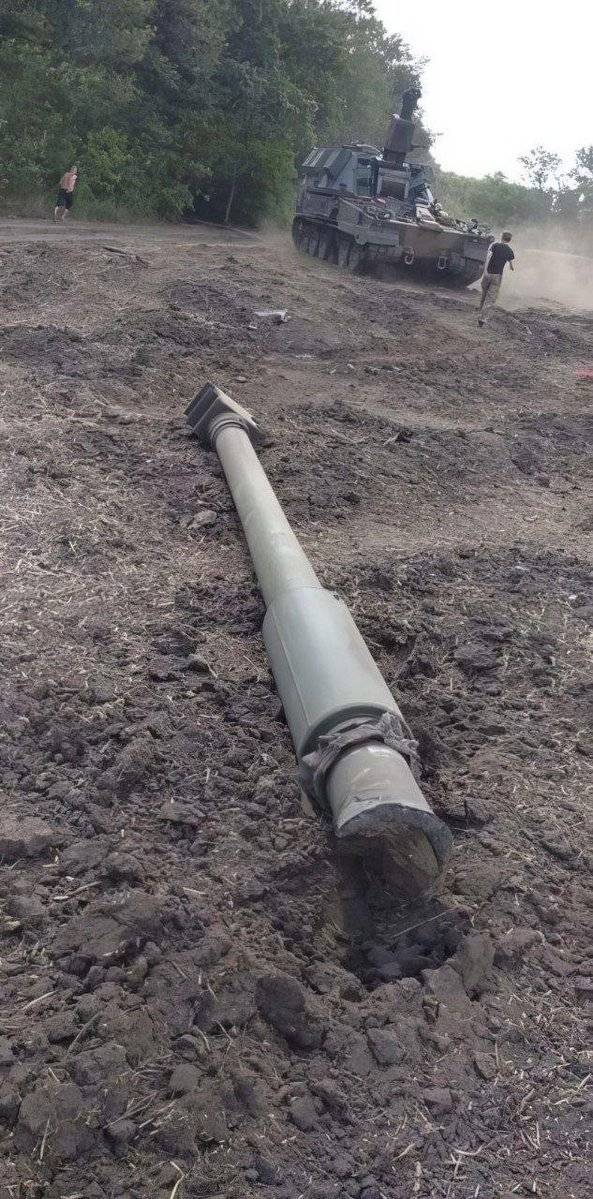Foreign shells for Ukrainian artillery

A batch of US M777 howitzers, May 2022. Photo by the US Department of Defense
Starting from February-March, foreign states regularly transferred to Ukraine various artillery systems and ammunition for them. To date, the total number of guns delivered has become three-digit, and the number of shots has exceeded one million. However, all the foreign aid of this kind did not pay much attention to the overall situation and did not improve the combat capability of the Ukrainian formations. In addition, these processes pose a threat to foreign armies.
Aid volumes
As part of military assistance, various artillery pieces in several calibers were supplied to Ukraine. Most of these items come from the USA. For example, according to a report dated October 14, 142 M777 155-mm howitzers, as well as 36 older 105-mm systems, were transferred or planned to be transferred to the Ukrainian regime as part of several aid packages.
Other countries also supplied artillery. For example, Germany, together with the Netherlands, has allocated 10 PzH 2000 self-propelled guns and is preparing to send 4 more. France, Great Britain and Poland have delivered dozens of several types of self-propelled guns and a significant number of towed systems. Eastern European countries transferred from the presence or from storage a small number of old Soviet-standard guns.
The United States also became the main supplier of ammunition. A recent report reports the transfer of 903 155mm rounds. In addition to "ordinary" high-explosive fragmentation ammunition, 3 high-precision projectiles and 7 RAAM remote mining projectiles were handed over. 180 shells of 105 mm caliber were also delivered.

Howitzer D-20 with a tractor a moment before the missile hit. Photo by the Ministry of Defense of the Russian Federation
In a recent report, the German Ministry of Defense mentions the delivery of 10500 rounds in 155 mm caliber. In addition, 2 smoke shells and 255 lighting shells were handed over. In the near future, it is planned to supply XNUMX Vulcano guided munitions. Similar or larger deliveries were made by other countries.
Thus, to date, foreign partners have transferred to the Kyiv regime up to several hundred artillery pieces in calibers of 105, 152 and 155 mm in self-propelled and towed versions. The total number of shots delivered has already exceeded 1,1 million. At the same time, the US and allies are already talking about new military aid packages, which will again include artillery shells. Accordingly, the total volume of deliveries will continue to grow.
Loss Percentage
However, quantity does not translate into quality. Ukrainian formations cannot realize the full potential of supplies and change the situation in the combat zone. This is hindered by a number of objective factors related to the peculiarities of the combat work of the Ukrainian artillery and the influence of the Russian army.
As practice has shown, the volume of supplies of artillery is insufficient to restore losses and create groupings of sufficient strength. At the same time, the Russian army regularly knocks out newly transferred guns. As a result, the potential of Ukrainian artillery, at least, is not growing, and restoration without foreign assistance is impossible.

British-made howitzer L119. Photo Telegram / ChDambiev
The same is true with ammunition. It is regularly reported about the destruction of warehouses of rocket and artillery weapons in different regions of Ukraine. Depending on the size of such a target, both hundreds and tens of thousands of shells can be destroyed with one blow. In addition, search and destruction of guns at firing positions or camouflaged parking lots is carried out. In this case, fire weapons knock out not only ammunition, but also weapons.
The exact number of shells destroyed is unknown and cannot be established. Judging by the intensity of the strikes and the published data, the enemy lost tens or even hundreds of thousands of shots. Perhaps we are talking about tens of percent of the total supply. At the same time, the process of destroying artillery and its ammunition does not actually stop.
Unfortunately, far from all Ukrainian stockpiles of shells have been destroyed so far. This allows enemy formations to bombard cities and terrorize the civilian population. However, the gradual destruction of accumulated and incoming shots reduces the risks for the liberated territories and their inhabitants.
Income and consumption
According to American estimates, Ukrainian artillery consumes approx. 15 thousand shells weekly. In addition, there are regular losses of ammunition due to Russian strikes. All this leads to the need to continue deliveries, and foreign partners are still able to carry them out. However, such aid threatens their own armies.
Foreign armies send shells to Ukraine from their own warehouses. Accordingly, the accumulated reserves are depleted, and they need to be replenished, but this is associated with unnecessary expenses and other difficulties of various kinds. Obviously, not all foreign countries will be able to cope with these problems. Even the US, for all its strengths, will be forced to look for suitable solutions.

FH-70 gun, presumably from Italy. Photo by the Ministry of Defense of Ukraine
Reportedly, the draft US military budget for the next fiscal year provided for the purchase of approx. 29 thousand shells of the main types. This is equivalent to a two-week expenditure of the Ukrainian army, or 2,7% of the total amount of assistance provided. If necessary, production can be increased by almost 10 times, but even in this case it will be extremely difficult to replenish stocks and help Ukraine at the same time.
Other countries do not even have such production capacities and cannot build them. In addition, they are not able to purchase the required number of shells from foreign manufacturers. Not everyone has free money for this, and the production capacity is already occupied and / or insufficient to fulfill all possible orders.
Suggested Solutions
In general, the situation in Ukraine is developing according to a scenario that is negative for the Kyiv regime. However, the US and allies intend to continue to support him, incl. through the supply of arms and equipment. In doing so, they are faced with specific problems and are now trying to find a solution for them.
Foreign partners are again going to supply Ukraine with artillery systems and ammunition for them, and again we are talking about products from stock. It is curious that measures are already being proposed to combat the depletion of warehouses.

Polish self-propelled gun Krab after excessively intense shooting. Photo Telegram / BMPD
Thus, the existing "Contact Group" will have to study the possibilities of different countries and draw up new assistance packages taking into account these data. It is assumed that this will ensure the necessary volumes and pace of supplies, but will reduce the burden on individual countries and reduce the risks for their armies.
With an eye to the medium and long term, it is proposed to expand the production of ammunition and guns. Due to new release products, incl. promising types, will restore arsenals and parks. However, the possibility of solving such problems in the current conditions, in the presence of a mass of difficulties and crisis phenomena, raises doubts.
How realistic such plans and proposals are is a big question. To answer it, you need to know how long deliveries to Ukraine will continue, how much more weapons will go there, as well as how many products will be needed to restore stocks. Probably, foreign states cannot yet answer these questions themselves.
Doubtful future
Thus, in recent months Ukraine has received more than a million artillery rounds of various calibers and types, but they have practically not affected the combat capability of the armed formations. Much of this aid has been successfully knocked out in the rear, and the remaining ammunition depots and transporters are being hit close to the front lines. All this sharply reduces the possible effectiveness of artillery.
Foreign countries, providing assistance to the Kyiv regime, create a difficult situation for themselves. They understand this and are already looking for ways out. How effective and useful the current proposals will be remains to be seen. However, in the foreseeable future, the United States and its allies will be able to learn this from their own experience.
Information